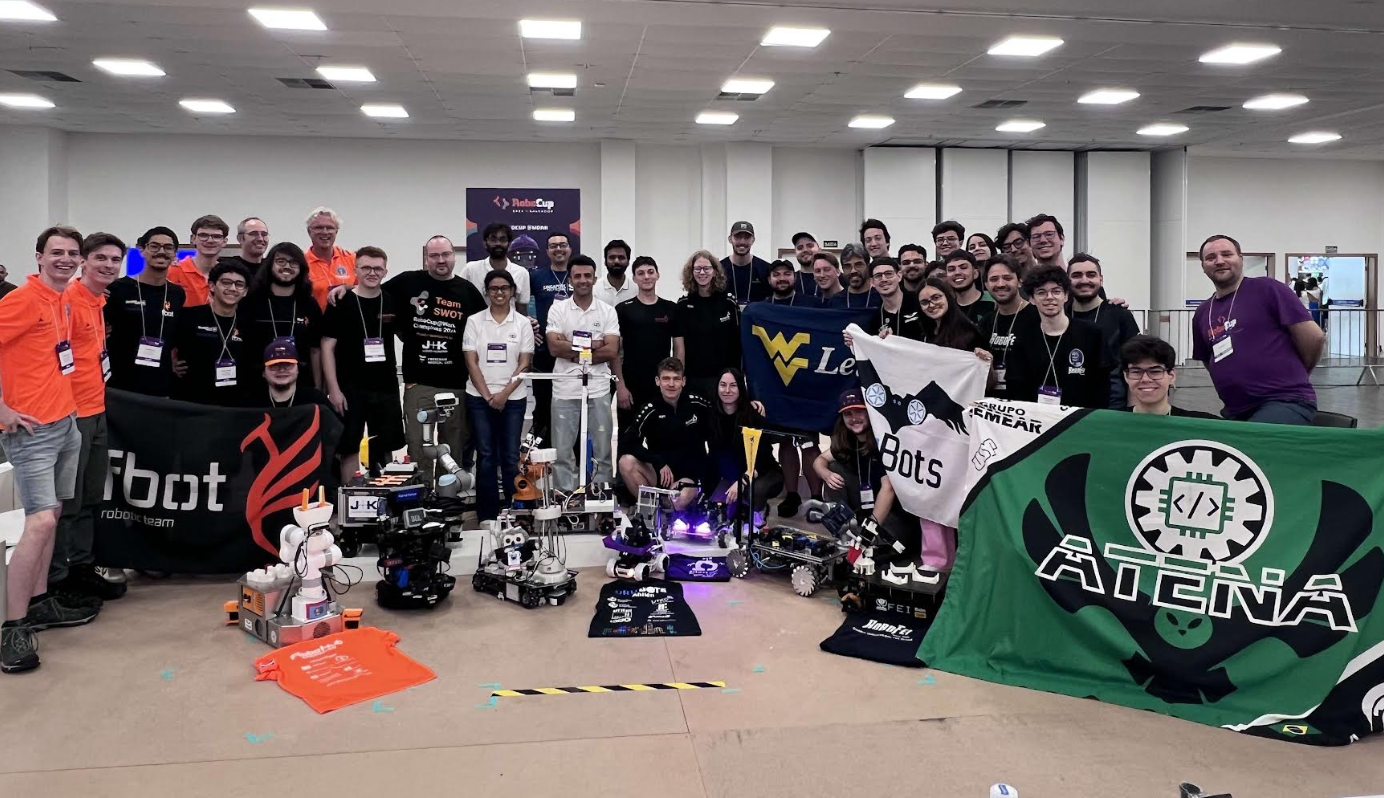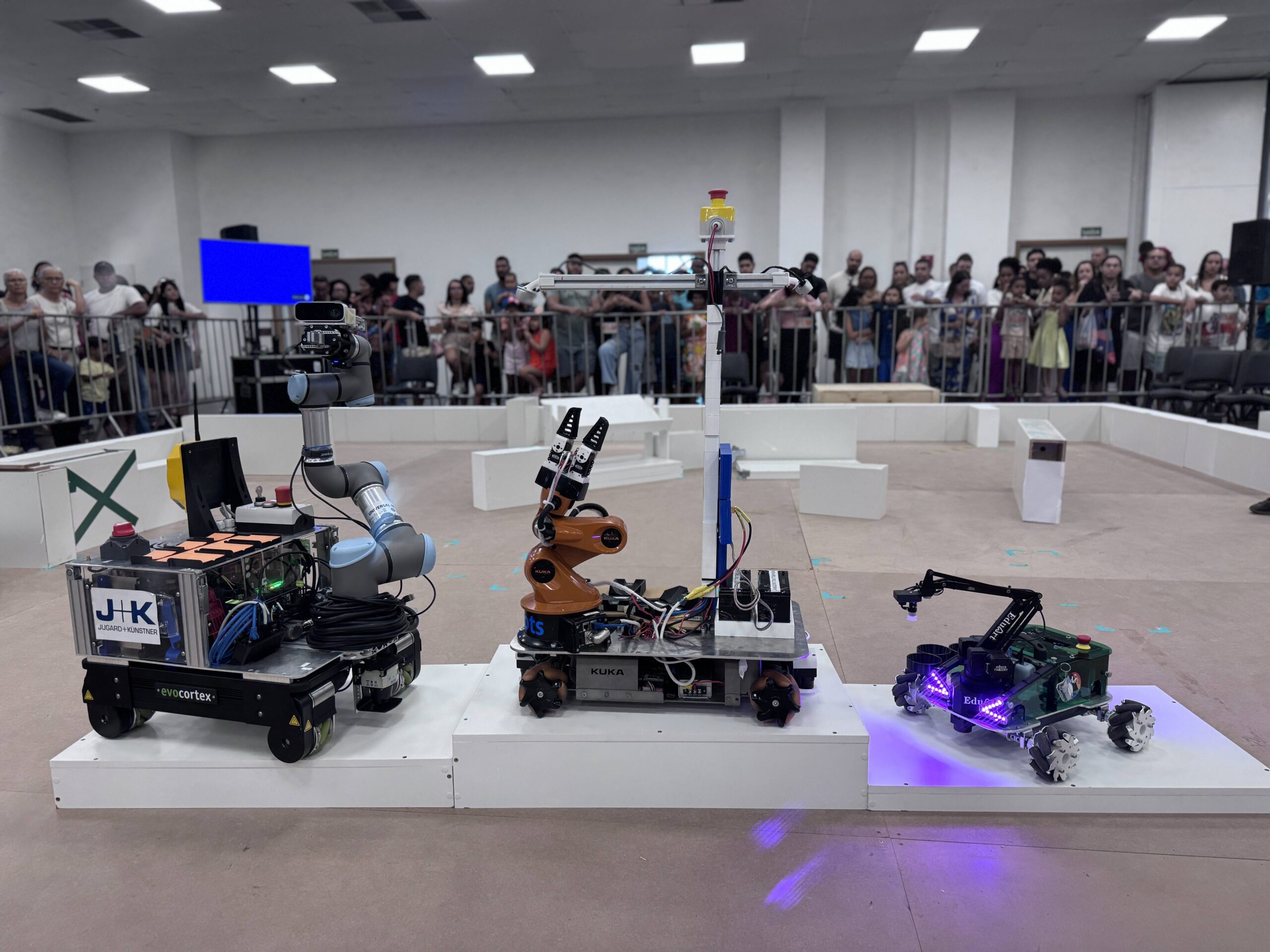 RoboCup@Work League teams at the event in Brazil.
RoboCup@Work League teams at the event in Brazil.
RoboCup is an international scientific initiative with the goal of advancing the state of the art of intelligent robots, AI and automation. The annual RoboCup event, where teams gather from across the globe to take part in competitions across a number of leagues, this year took place in Salvador, Brazil from 15-21 July. In a series of interviews, we’ve been meeting some of the RoboCup trustees, committee members, and participants, to find out more about their respective leagues. Christoph Steup is an Executive Committee member and oversees the @Work League. Ahead of the event in Brazil, we spoke to Christoph to find out more about the @Work League, the tasks that teams need to complete, and future plans for the League.
Could you start by giving us an introduction to the @Work league?
The @Work League, along with the Logistics League, forms the Industrial League. Our goal is to mimic some of the aspects of industrial production systems. An important aspect of this is factory automization and trying to mimic the factory of the future, where you have autonomous robots building products according to customer design. In these factories of the future, a single piece would be produced individually for each customer. Factories nowadays have big conveyor belts and a lot of automization, with the tasks mostly done in the same way, and you can only build stuff efficiently if you build millions of items. We are working on building individual pieces, where automization is still possible, and even a single piece can be built effectively. But obviously, in our RoboCup competitions, we are not interested in building on a factory scale – we are doing it on a very small scale. That means our robots are typically 80 centimeters long, the largest are around 70 centimeters wide, and some of them are also 80 centimeters high. So let’s say they fit in a one metre cubed box. Also, all our operations are done on the ground. This is just for simplification because building big tables to make it more realistic would also increase the cost for RoboCup and wouldn’t give much additional value.
What our robots need to do is transport objects from different workstations. So we have a default configuration where the arena starts, and there are workstations with objects lying on them, and some of these objects need to be transported to other workstations. The robot needs to do that completely autonomously. So this is one of the special things about the @Work League, that it’s completely autonomous and there is only a single restart allowed per team. So that means the robot really needs to be reliable. One of the big differences between medium teams and very good teams is that the very good teams perform well all the time whereas the medium teams have some good runs and some bad runs.
As well as the object transportation that you mentioned, and there other tasks that the teams need to carry out?
There are some special tasks in our league, like the precision placement task where the robot needs to fit an object into a cavity that is essentially the same shape and size as the object. It’s a little bit like the game that babies do to train their dexterity.
We also have a task that is inspired by a conveyor belt, but we are using a table that is constantly turning. The robots need to grasp stuff while the table is turning. This looks a little bit silly because no one would actually put a rotating table in a factory, however this is our way of actually mimicking a conveyor belt. The conveyor belt itself would be really, really difficult to integrate into the competition, so we just abstracted that and use this rotating table to actually have the same challenge but in a more manageable way. And it’s still a very, very hard challenge.
Then there are some special challenges that we integrate. For example, that robots need to report their state back so that we can observe what the robot is doing. We also have a challenge where humans are in the loop. For example, the robot brings pieces to a certain workstation where a human is present, the human assembles the pieces, and then the human needs to give a sign to the robot, and then the robot will take the piece away and put it somewhere else. This is designed to really mimic the automated factory flow.
In the past we also had a challenge where the robots needed to open a drawer, take something out and then close the drawer again. We’ve also had tasks where the robot has to handle fragile objects, like sweets, where the robot really needed to be careful in manipulating them. So in general, what differentiates us most from the Logistics League is that we are focusing a lot on manipulation and all the difficulties that come with manipulation and unknown objects, whereas Logistics is more tailored towards large-scale logistics processes with all their optimization and planning.
I was lucky enough to attend RoboCup last year in Eindhoven and what the teams were doing was really impressive. It was also interesting to see how varied the robots were, and how teams were approaching the tasks in distinct ways, with different grabbers and so on.
Yes, this difference in approaches is related to the history of our League, which is a little bit similar to the Logistics League. The Logistics League was originally a sponsored demonstration by Festo, which is a large company from Germany that creates tools, but they also have a didactics area where they provide tools to help people understand factory optimization. The @Work League was sponsored by Kuka, the robotics company, and, in the beginning, they required every team to compete with the Kuka youBot. So this was pretty much the default platform for our league, but at some point Kuka dropped from a sponsor to just an advisor to the league, and nowadays they are not part of the league at all. So when the Kuka youBot was going out of commission, the teams searched for alternatives and now we are presented with a wide variety of robots that are competing in the league, which I personally find really cool. Now we have all these different robots, all these different approaches, and some work better in some scenarios and worse in others. So we really have a scientific approach to the problem and we are really getting some insights into how you can tackle this problem on multiple levels.
Have you noticed that some of the challenges specifically are more difficult in general for all the teams?
In 2018 we introduced a challenge of so-called arbitrary surfaces which are surfaces unknown to the teams that are put on top of the workstations. The teams need to be able to deal with these surfaces. There are two surfaces that are really, really awful for the teams – one is grass that we pretty much stole from the soccer competitions! We just thought it would be funny to try it, and it was a really interesting problem, especially for some of the grippers of the different teams. For example, the current world champion, they have a rigid gripper so they can have force feedback when they grasp. However, the grass is really difficult for them – because of their rigidity, they always grasp the grass itself and then they pull up the grass with the object. And this led to some interesting problems, like they are transporting the actual surface around and not only the object. This isn’t a problem for teams using a flexible gripper. However, on the other hand, the flexible gripper makes it really difficult to assess if you have grasped the object because you have very bad force feedback. So there are two different approaches that have their pros and cons in different scenarios.
 Three robots from the @Work competition in Brazil.
Three robots from the @Work competition in Brazil.
Are you introducing any new tasks for this year?
Yes and no. So actually we are introducing a completely new challenge which is different from what we’ve done before. The new challenge is the so-called smart farming challenge, which is opening our league to a whole new field of applications, because we are now looking at agriculture. We are working on this with Studica, a robotics company from Canada, whose hardware we are using. We’ve already given it a try at the German Open. This challenge comes with some new specifics and one these is that the teams only get the robot shortly before the competition. So they don’t really know the robot largely in advance, and they need to assemble, program and design the robot in a very short time. To compensate for this, we reduce the amount of optimization and robustness that is necessary. Because it’s an agriculture setting, we have different objects, like fruits, that the teams need to handle. This makes it a little bit more complicated because fruits have a more arbitrary shape and different levels of ripeness that need to be detected. We also have some grapes that are hanging on a wall, which is a completely different kind of manipulation task than before, because before the teams just needed to grasp things from surfaces, but now they really need to pluck stuff from a wall in a reliable way. So this is the new challenge. It also comes with a lot of software challenges because the computational power of this robot is very limited because it only has a Raspberry Pi. For example, there is not a lot of image processing possible, especially compared to the current robots, some of which even have GPUs embedded.
Is there a particular part of the hardware or software that you’ve seen some of the biggest developments in over the last year or so?
Yeah, I think one big change I observed over the years was a switch from custom neural networks for object detection to off-the-shelf components. So pretty much all teams nowadays use YOLO networks, which you can get pre-trained and they just deploy them on GPUs that they embedded into their robots. This is also one of the reasons why the robots really grew in size over the last few years because they needed space for the larger computational power. This actually made it possible for a lot of teams to reliably detect the objects. Object detection was a big problem in the beginning of the league and nowadays it’s not really a big issue – most teams are really good at that. Sometimes they are a little bit startled with decoy objects – these are objects in the arena that are not really part of the task, and they are unknown to the teams beforehand. Sometimes they are, let’s say, evil decoys that look like an object and there’s some mismatches that the teams do, but this is becoming very rare.
I think the second big change is a switch to larger manipulators with more degrees of freedom. So in the beginning, everyone had a very small manipulator with only five degrees of freedom, which limited the operating range, and nowadays pretty much all teams have a six degree of freedom manipulator with a large range. This means that they don’t need to move their robot when they are in front of a workstation, which makes them much faster and also much more precise.
Could you talk about the future plans for the League?
There are a few things we are thinking about.
With regards to the competition itself, we had a discussion with the teams about what they are interested in doing in the future. Two things came up that they really want to have. One is mobile obstacles, so they want other objects to move autonomously through the arena. We’re in the process of creating that, in cooperation with EduArt, which is a company from Germany that also provides small educational robots. And the second thing we want to introduce is a kind of humanoid robot that the teams can use to actually handle special manipulation tasks that cannot be done simply with a robot manipulator.
In terms of creating an entry-level League, we have been working on this and one potential idea is to use the smart-farming challenge as the entry point. Through the collaboration with Studica, we can provide teams with the robot and they get to keep it after the competition. At the German Open I spoke to the Rapidly-Manufactured Rescue League about this crossover between the Rescue and the Junior Leagues, and they are very keen to collaborate.
We’re also talking with the Logistics League. Their sponsor, Festo, has dropped out of their league and now they need to reorganize. We are wondering if it would be worthwhile to bring our leagues closer together, or even fuse them together to a single RoboCup Industrial league. The Logistics League wants to do more manipulation, and the @Work League wants to do more planning, so we are closing the gap naturally between the two. However, this is just a thought at the moment – we need to see how the teams react to that.
About Christoph

|
Christoph Steup is an active researcher specializing in various fields of robotics, including swarm robotics, precision farming, and weather-resilient autonomous driving. He currently works at the Fraunhofer Institute for Transportation and Infrastructure Systems (IVI), where he leads the Swarm Technology Group. Prior to this role, he headed the Computational Intelligence in Robotics group at the Otto von Guericke University Magdeburg. Christoph’s involvement with RoboCup began in 2015 when he joined the robOTTO team of Otto von Guericke University as team leader. His contributions to the RoboCup community expanded as he became a member of the Technical Committee for the @Work League in 2017. In 2019, he further advanced his participation by joining the Executive Committee of the league. |